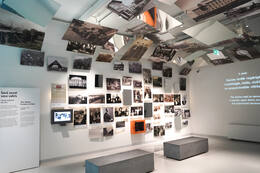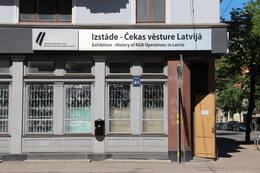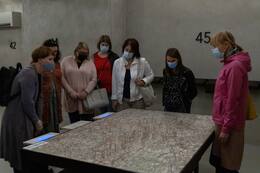Pretpadomju aģitācija un propaganda
IV Padomju okupācija
″Pretpadomju aģitācija un propaganda″ - izteikti ideoloģisks termins, kas PSRS kriminālajā likumdošanā tika ieviests jau kopš 20. gadsimta divdesmitajiem gadiem un politiskajās prāvās bija viens no visbiežāk izmantotajiem likuma pantiem. KPFSR 1926. gada kriminālkodeksā atbildība par ″pretpadomju aģitāciju un propagandu″ bija noteikta 58. pantā.
Pēc Latvijas okupācijas, 1940. gada novembrī šis Kriminālkodekss, turklāt ar atpakaļejošu spēku, tika ieviests arī Latvijā. 1961. gadā tika pieņemts un stājās spēkā Latvijas PSR Kriminālkodekss, kurā atbildība par ″pretpadomju aģitāciju un propagandu″ bija paredzēta 65. pantā. Šā panta sankcijā noteiktais sods paredzēja ″brīvības atņemšanu uz laiku no sešiem mēnešiem līdz septiņiem gadiem″, kā arī ″nometinājumu uz laiku no diviem līdz pieciem gadiem″. Savukārt personām, kas jau agrāk bija notiesātas ″par sevišķi bīstamiem valsts noziegumiem″ 65. panta otrajā daļā bija paredzēts sods pat ″no trim līdz desmit gadiem″ ieslodzījumā, turklāt vēl ar ″nometinājumu uz laiku no diviem līdz pieciem gadiem″.
Latvijas Valsts arhīvā VDK izmeklēto krimināllietu fondā pēdējās politiskās krimināllietas datētas ar 1986. gadu. Ļoti daudz dokumentu 1980.-1990. gadu mijā VDK paspēja izvest uz Krieviju vai iznīcināt.
Papildus izziņas avoti
1983.gada politiskās prāvas okupētajā Latvijā. Virtuāla izstāde. Latvijas Nacionālais arhīvs, 2013. http://www.archiv.org.lv/1983/index.php?id=303
Gints Zelmenis, Bruno Javoišs, Ivo Grundulis. Nacionālā pretošanās kustība Latvijā no 1959. līdz 1986.gadam. Rīga, 2019.
Jānis Ķeruss: čekas vēršanās pret pretpadomju propagandu un aģitāciju. 1957. gada analīze. https://www.lu.lv/vdkkomisija/zinas/t/23701/
Māra Miķelsone. Vēsturnieks Zelmenis: totalitārais režīms bija jutīgs pat pret simboliskām akcijām. Ir., 2019. gada 16.septembrī. https://ir.lv/2019/09/16/vesturnieks-zelmenis-totalitarais-rezims-bija-jutigs-pret-simboliskam-akcijam/
Saistītie objekti
Latvijas Okupācijas muzejs
Latvijas Okupācijas muzejs aicina izzināt Latvijas okupācijas stāstu no 1940. līdz 1991. gadam par Padomju Savienības un nacionālsociālistiskās Vācijas okupācijas režīmu valdīšanu.
Ekspozīcijas koncepcija, dizains un realizācija – dizaina birojs H2E.
Ekspozīcija atklāta 2022. gada 30. maijā.
www.okupacijasmuzejs.lv
+371 67229255
Stūra mājas izstāde "Čekas vēsture Latvijā"
Atrodas Rīgā, Brīvības un Stabu ielu krustojumā.
1911. gadā būvētais nams ir viens no skaistākajiem Rīgā. Tautā saukts par “Stūra māju”, ir baisākais Padomju okupācijas režīma simbols Latvijā. “Čeka” bija īpaši represīva struktūra - viens no PSRS varas balstiem. Tās darbība Latvijā cieši saistīta ar ēku Brīvības un Stabu ielas stūrī.
“Stūra mājā” čeka darbojās okupācijas laikā no 1940.gada līdz 1941. gadam un atkal, sākot no 1945.gada līdz 1991. gadam. Politiskās vajāšanas tiešā veidā skāra ap desmitiem tūkstošu Latvijas iedzīvotāju. Padomju varas pretinieku apkarošana turpinājās arī pēc 2. pasaules kara. Čekas darbības metodes nedaudz mainījās pēc Staļina nāves. Fizisku mocīšanu nomainīja psiholoģisks terors. Vairākums čekas aģentu bija latvieši (52%). Krievi bija otrā lielākā grupa - 23,7 %. 60,3% aģentu nebija Komunistiskās partijas biedri. Augstākā izglītība bija 26,9% aģentu. Sistēma bija veidota, lai iesaistītu vietējos iedzīvotājus un tādējādi panāktu kontroli pār sabiedrību. Čekas darbības metodes Latvijā nav pilnībā izpētītas. Darbinieku saraksti un dienesta lietas atrodas Krievijā. Latvijas varas iestādēm un pētniekiem tās nav pieejamas.
Mūsdienās var aplūkot Latvijas Okupācijas muzeja izstādi par “čekas” darbību Latvijā. Kopā ar gidu var izstaigāt cietuma kameras, gaiteņus, pagrabu un iekšpagalmu.
Vēstures ekspozīcija "Sirdsapziņas ugunskurs"
Atrodas Pils ielā 12, Cēsīs, netālu no Cēsu pils laukuma.
Vēstures ekspozīcija "Sirdsapziņas ugunskurs" atklāj pārsteidzošus un varonību apliecinošus indivīdu pretošanās stāstus.
Ekspozīcija izveidota padomju laika īslaicīgās aizturēšanas izolatorā un vēsta par Latvijas okupāciju.
1940-tajos gados Latviju divreiz okupēja Padomju Savienība un nacionālsociālistiskā Vācija. Līdz pat 1950-to gadu vidum kādreizējā Cēsu apriņķa iedzīvotāji, tāpat kā viņu laikabiedri citviet Latvijā, aktīvi pretojās totalitārajiem okupācijas režīmiem.
Ekspozīcija sniedz padziļinātu ieskatu vietējās kopienas patriotismā un motivācijā. Laika līnija rosina izzināt Latvijas okupācijas norisi no 1939. līdz 1957. gadam un tematiski sakārtoti citāti no vietējiem laikrakstiem piedāvā salīdzināt abu okupācijas režīmu politisko propagandu.
Īslaicīgajai ieslodzīšanai paredzētās sešas kameras līdz mūsdienām saglabājušas tādas, kādas tās bija 1940./41. gadā un pēckara gados. Šeit, pirms nosūtīšanas uz čekas galveno ēku Rīgā, vairākas dienas, kamēr notika sākotnējā izmeklēšana un pratināšana, bija ieslodzīti tie Cēsu apriņķa iedzīvotāji, kurus aizturēja par visdažādākajām pretpadomju darbības izpausmēm – nacionālie partizāni, viņu atbalstītāji, jaunieši, kuri izplatīja “pretpadomju” satura lapiņas un citi “dzimtenes nodevēji”. Viss šeit ir īsts – kameras ar dzelzs durvīm, kur iebūvētas “kormuškas” (nelielas atveres ēdienu padošanai), koka nāras, ateja arestantiem, neliela virtuvīte ar krāsni, tipiskais padomju laika eļļas krāsu sienu krāsojums.
2019.gadā ekspozīcija ieguva Latvijas Dizaina gada balvā 3.vietu.
2015. gadā Pils ielas 12 pagalmā atklāja piemiņas sienu ar 643 padomju represijās bojāgājušo agrākā Cēsu apriņķa iedzīvotāju vārdiem – gan 1941. un 1949. gadā izsūtītajiem, gan nošautajiem un ar nāvi sodītajiem nacionālajiem partizāniem.
Otrā pusē ceļam apskatāma Cēsu “Stūra māja” - bijušais čekas nams.
Saistītie stāsti
Liepāja - dažādu vēstures notikumu krustcelēs
Liepājas iedzīvotāji bija vieni no pirmajiem, kuri Latvijā izjuta Otrā pasaules kara sākumu un vieni no pēdējiem, kuriem karš gan tiešā gan simboliskā ziņā beidzās visvēlāk. Otrais pasaules karš un padomju okupācija Liepājā beidzās tikai 1994. gadā, kad to atstāja pēdējās PSRS mantinieces - Krievijas - karaspēka daļas.







